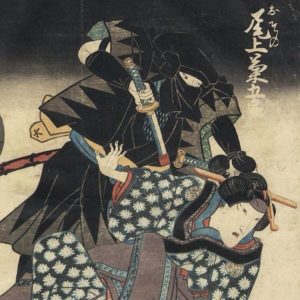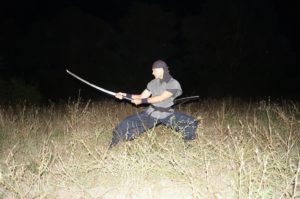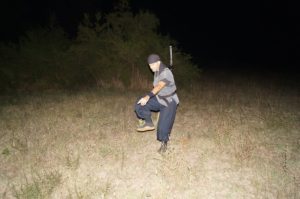Fifty eight kilometres in 12 hours were walked by the participants in the seminar The Path of Shugenja, which was held yesterday.
On „The Final Journey“, 13 members from Bujinkan Macedonia and two guests were participating. Unfortunately, halfway of the predicted route, one of them had to quit because of health problems, caused by the great strain.
The seminar started at 08.00 hours, when after short preparations, the group directed herself to the slopes of Lipac. After hour of climbing, Beljakovski Monastery was reached, and then the participants continued south, to Pezovo. On the halfway to the village, one of the participants of the seminar started to experience health problems, after what shidoshi Dovezenski had to decrease the movement speed. With a turn to south-east, the group headed to the village Tatomir, where the frail one was sent by a car to Skopje. Because of the unplanned detour, a slight change was made to the plan, so instead of of the finishing point to be Skala, the group made a circle arc to the north walking around the west part of Sekulica. With the gradual decrease of elevation, the participants got down to the bed of River Kriva Reka in the village Shopsko Rudare. Moving to the west, through Konjuh, they entered the village Beljakovce. Five kilometres until the starting point, in honor of The Final Journey, the members of Bujinkan Macedonia did fifty push-ups with full gear on, and then walked the last kilometres. After reaching the starting point of the route, shidoshi Dovezenski announced this seven-year feat as closed.
The calculations that were made with the help of army maps and satellite navigation, showed that in 12 hours sharp, 58 kilometres were walked in hill, mountain and difficult to pass terrain.

 Ninjutsu is an old martial art that has until today remained covered with mystery, therefore it is so little known even for the Japanese people. In medieval Japan, in the times when it was divided among several commanders, often there was a clash between their armies lead by the samurai warriors. For the samurai it was a great honor to die in the battlefield because their code said so. On the other hand, the code of the bushi (warriors) do not apply for the ninja. They used to use special, unconventional way of fight. For them, the only thing that mattered was how to fulfill the task, to protect ones own family and to survive. That was their code.
Ninjutsu is an old martial art that has until today remained covered with mystery, therefore it is so little known even for the Japanese people. In medieval Japan, in the times when it was divided among several commanders, often there was a clash between their armies lead by the samurai warriors. For the samurai it was a great honor to die in the battlefield because their code said so. On the other hand, the code of the bushi (warriors) do not apply for the ninja. They used to use special, unconventional way of fight. For them, the only thing that mattered was how to fulfill the task, to protect ones own family and to survive. That was their code. Ninjutsu teach us how to understand the Universe and how to establish a harmony with the nature. It helps us to develop our mental and physical potentials, to develop our own creativity, to enhance our individuality, to increase the self-esteem and goodness, to deepen our life and to learn to enjoy it more. In one word, to become tatsujin (complete person who is able to succeed in any segment of the life).
Ninjutsu teach us how to understand the Universe and how to establish a harmony with the nature. It helps us to develop our mental and physical potentials, to develop our own creativity, to enhance our individuality, to increase the self-esteem and goodness, to deepen our life and to learn to enjoy it more. In one word, to become tatsujin (complete person who is able to succeed in any segment of the life). Practicing ninjutsu is an honor. Through training we understand the joy of life and the true values. Differing from the other popular Japanese martial arts, such as aikido, judo or karate, that have become recreational or sport disciplines aiming to achieve sport results or to recreate, ninjutsu helps us to survive in the daily situations. The goal of this martial art is to teach us how to defend our life with the least consequences for our body and spirit, and with the large scale consequences for the enemy.
Practicing ninjutsu is an honor. Through training we understand the joy of life and the true values. Differing from the other popular Japanese martial arts, such as aikido, judo or karate, that have become recreational or sport disciplines aiming to achieve sport results or to recreate, ninjutsu helps us to survive in the daily situations. The goal of this martial art is to teach us how to defend our life with the least consequences for our body and spirit, and with the large scale consequences for the enemy. Ninjutsu
Ninjutsu